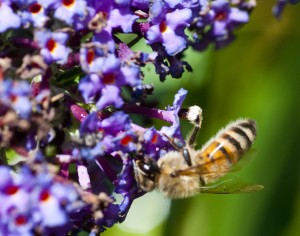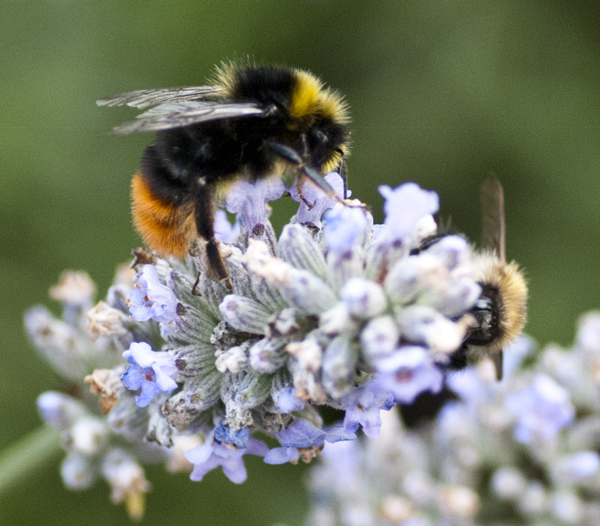Bees and bumblebees – neonicotinoids

DDT was used an insecticide at the onset of WW2, with great success in terms of controlling malaria and typhus among civilians and troops. After the war, it was available as an agricultural insecticide. However, within a few years, there were warning signs that not all was well and in 1946, the Soil Association journal read as follows "By the wholesale use of powerful insecticides of which far too little is yet known, we may well be upsetting the whole balance of Nature. We are like schoolboys rat-hunting in a munition dump with a flame-thrower."
Some years later (in 1962), Rachel Carson published ‘Silent Spring’ – which seriously questioned the use of organochlorines, such as DDT and warned of the dangers of the indiscriminate use of insecticides. The use of these chemicals continued despite
- evidence of bio-accumulation in food chains and ecosystems (that is the chemicals being passed from one feeding / trophic level to the next – with an increase in concentration): and
- specific effects such as the thinning of the egg shells of birds of prey – so chicks failed to hatch and populations (of eagles, sparrowhawks and peregrines) declined.
It was not until a decade later that the use of DDT was banned or severely limited.
 Just as then, so now the use of (other) insecticides is being questioned, specifically the neonicotinoids. These are used for seed dressings in crops such as oil seed rape and maize. Even in very low concentrations (within the ‘safe’ limits set by various authorities) there is accumulating evidence that these chemicals are proving damaging to bees and bumblebees. Bees and bumblebees are important pollinators, from strawberries, lychees, macadamias, apples, alfalfa, kidney beans, plums, greengages, tamarinds, blueberries, grapes to cranberries.
Just as then, so now the use of (other) insecticides is being questioned, specifically the neonicotinoids. These are used for seed dressings in crops such as oil seed rape and maize. Even in very low concentrations (within the ‘safe’ limits set by various authorities) there is accumulating evidence that these chemicals are proving damaging to bees and bumblebees. Bees and bumblebees are important pollinators, from strawberries, lychees, macadamias, apples, alfalfa, kidney beans, plums, greengages, tamarinds, blueberries, grapes to cranberries.
Various studies and papers seem to indicate that low concentrations affect the bees homing ability – to the extent that some do not make it ‘back home’, also the number of (bumblebee) queens produced. To quote again from the Soil Association “The chemicals impair their communication, homing and foraging ability, flight activity, olfactory discrimination (smell is also vital to bees communication systems), and learning, and a weakened immune system.“ The use of certain neonicotinoids has been limited in France.
The importance of bees and bumblebees cannot be over-stated – so many of our crops are dependent upon them. Bees (and bumblebees) are also threatened by loss of habitat and forage, viral parasites and mites such as varroa. These have all contributed to the decline in bees / bumblebee populations in recent times.
The Environment Secretary, Mr Owen Paterson has apparently asked officials in his Department (Defra) to examine the consequences of limiting the use of neonicotinoids, according to a report in The Independent and the Royal Society for the Protection of Birds (RSPB) has called for a ban on these insecticides -
Comments are closed for this post.
Discussion
[…] evidence of the effects of neonicotinoids (other than that already reported in the woodlands’ blog) comes from the research work of Professor Raine * (of the University of Guelph, Ontario, Canada) […]
[…] still a cause for concern – a general decline in the numbers of many insects associated with the use of pesticides and habitat loss / […]
There have been many papers from a variety of reputable scientific institutions that detail the effects of
long term use of DDT,
its breakdown products and
bio-accumulation of residues.
Indeed. Indiscriminate use of any pesticide, medicine, drug, or otherwise healthy food, drink, etc, causes problems. But the demonising of DDT and the false accusations of birds egg shell thinning, and its complete ban, has cost millions of lives. Ban indiscriminate use, of course. Banning it altogether has had a genocidal effect.
Whilst no one doubts its efficiency in terms of control of malaria – anopheline mosquitoes etc – it was the widespread and indiscriminate use of DDT (and other insecticides) that was cause for concern.
Repeating this nonsense about DDT is an insult to the memories if the millions of people who have died of malaria and who should have lived. There was no evidence of harm of correctly deployed DDT, and still isn’t. The refusal of people to use and trust science, at the expense of literally millions of lives, is appalling.
http://www.wired.com/wiredscience/2012/08/ff_apocalypsenot/all
Went to Hodsock Priory (North Notts) on Tuesday to see the snowdrops etc and it was a lovely, warm sunny day for February.
They have their own hives and it was great to see lots of honeybees on the crocuses, even at this time of year.
Living next to a corn field, I have witnessed the decimation of bees. Walking on the footpath one day after the field was sprayed, I could not understand why thousands of bees were on the ground – walking and spinning around and flipping on their backs, when thet tried to fly. Getting up and doing it all over again.
Next day, all that was on the ground wherever you walked were dead bees. The flocks of birds that followed over the next few days quickly disposed of them.
Don’t farmers have any brains to kill off the propergators of there own corn ?
Has the world gone mad?


[…] the start of the 2018 Great British Bee Count. The aim of the count is to estimate the number of bumblebees and solitary bees that are buzzing around this year. As the woodlands blog has reported on many […]
The Great British Bee Count (and App) – 2018. | Woodlands.co.uk
19 May, 2018